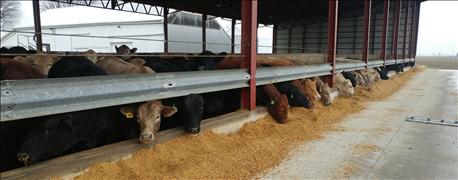December 13, 2016

Weaning is a normal process in beef production, where the newly weaned calf is denied both its dam’s milk and social contact with her and other adults. Newly weaned calves are subjected to numerous nutritional, behavioral and immunological stressors immediately before and during the weaning, marketing and transportation process, as well as upon arrival at the feedlot or backgrounding facility. The result is a period of prolonged vocalization (bawling), which may irritate the respiratory tract and increase susceptibility to bacterial and viral challenges.

BETTER TRANSITION: Research finds Amaferm helps weaning calves transition and perform better.
The exposure to new pathogenic organisms, and vaccines to which the calves must mount an immune response, both demand that calves be on an appropriate nutritional program in order to allow an adequate immune response. There is often no social order immediately following weaning, and this lack of social order means that it can take calves several days to learn how to eat from a feed bunk or drink from a new water source.
Also, the physical characteristics of the feedlot-receiving diet are often drier than pasture, or they may contain fermented feeds unfamiliar to the newly weaned calves. Finally, the calves are often exhausted following weaning, being trucked, sorted and mixed with unfamiliar calves, loaded back onto another truck, and trucked to a feedlot or backgrounding facility. During this time, both feed and water may be scarce.
These periods of feed and water deprivation, which normally occur when cattle are weaned and transported by truck, cause changes in the rumen environment and eating patterns of calves. These changes include a reduction in rumen solid and liquid volume, a reduction in average feed particle size and rumen dry matter percentage as rumination continues to occur in the absence of new feed, and a prolonged period of time to resume normal consumption levels following arrival. Therefore, a main goal as nutritionists during the first few weeks following weaning is to improve water and feed intake. Consequently, the diet offered to calves must be both palatable and digestible to allow for proper animal health and performance.
Use of antibiotics
The use of antibiotics in production livestock has become an issue that has found itself at the forefront of the industry. As consumer concerns continue to grow about the use and misuse of antibiotics given to livestock, producers are looking for alternative methods to increase production and performance of ruminant animals. Recent research found that a prebiotic derived from Aspergillus oryzae fermentation — AO-Biotics by BioZyme Inc. — modulates permeability of the intestinal mucosa and appears to stimulate the gut innate immune system.
These observations along with the absence of signs of enteral disorders and impaired growth in the study suggest that AO-Biotics improves the absorptive and immune competence of the gut via a multifactorial mechanism. The apparent immune-stimulating action of AO-Biotics may safeguard the gut against inflammation and damage resulting from the potentially augmented entry of bacterial products and dietary antigens (i.e., increased immune tolerance).
Increase in average daily gain
Recent research using a prebiotic derived from A. oryzae fermentation found that including 1 to 3 grams per head per day in corn-silage-based receiving diets containing Rumensin, and fed using a prescribed intake, had a linear increase in average daily gain (ADG) during the first two weeks, with the control cattle gaining 0.62 pound per day, the cattle receiving 1.5 grams per day Amaferm gaining 0.73 pound daily, and cattle receiving 3 grams of Amaferm gaining 1.23 pounds per day.
The importance of these results is that even with a prescription intake program, in a diet containing Rumensin, there was a benefit of having Amaferm in the diet. There was no mortality during the first two weeks of this experiment, which partially may be attributed to the six-week postweaning diet adaptation at the farms of origin for these cattle, prior to feedlot arrival. The ability of the Amaferm treatments to result in greater ADG indicates there was less metabolic stress, and greater diet digestibility during the first week in the feedlot.
This is a critical period, as reductions in animal performance resulting in weight loss during week 1 are indicative of a negative energy or protein status, which makes an animal less capable of mounting an immune response against pathogenic bacterial and viral challenges.
Some studies have shown Amaferm to:
• increase enzyme production by both cellulolytic and starch-digesting bacteria
• increase the rate and extent of digestion
• increase the microbial protein yield on a variety of diets, which provides essential protein to animals under stress during periods of reduced feed intake
• reduce the time that animals require to resume consumption during diet transition
Amaferm may be a useful tool when feedlot cattle are being transitioned from one diet to another, or are under any stress that may impact rumen stability or feed intake.
This research was not sponsored by BioZyme Inc.
Relling is a professor in the Department of Animal Sciences at Ohio State University. He can be reached at [email protected].
You May Also Like




